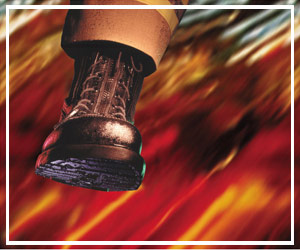
However, different brands focus on different qualities and not all are best suited for each individual. A fire watcher is liable to prefer a boot that is more comfortable than one who stands a dozen yards from an inferno fighting the blaze.
That is why we have put together a list of the 10 best wildland firefighting boots. Then, we provide a thorough buyer’s guide so you can identify which qualities of fire boots are best suited for your needs.
Top 10 Wildland Firefighting Boots Comparison Тable
| Brand boots | View | Upper | Sole | |
|---|---|---|---|---|
| Danner Men's Wildland Tactical Firefighter Work Boot (Editor’s Choice) |  | Fire resistant, durable rough-out leather | Vibram | Check Price |
| White's 400VLTT Smoke Jumper Lace-To-Toe Boot |  | Oil Tanned Fire Leather | Vibram | Check Price |
| Scarpa Fuego Mountaineering Boot |  | Leather for wildland firefighters | Vibram | Check Price |
| Thorogood Firestalker Elite Wildland Hiking Boot |  | Oil Tanned Fire Leather | Vibram | Check Price |
| Bates Men's Tactical Sport Side-Zip Boot |  | Leather/Fabric | Rubber | Check Price |
| Bates GX-8 Ultra-Lites GTX Waterproof Boot |  | Leather/Synthetic | Rubber | Check Price |
| Hathorn 110V Smoke Jumper Fighting Boot |  | Premium full grain all leather | Vibram | Check Price |
| Thorogood Men’s Side Zip Jump Boot Gen-flex |  | Oil-tanned leather | Rubber | Check Price |
| Thorogood Power EMS / Wildland Boots |  | Flame and Cut Resistant Leather | Vibram FIRE и ICE Slip Resisting | Check Price |
| La Sportiva Glacier Wildland Fire Hiking Boot |  | Leather | Rubber | Check Price |
1. Danner Men’s Wildland Tactical Firefighter Work Boot – Most Comfortable
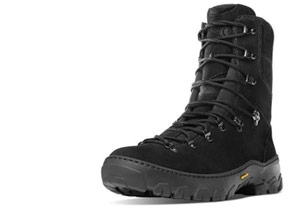
Danner is one of the premier fire boot manufacturers and is often considered the best in the business alongside White’s boots. However, the two companies take a fairly different approach to what their boots provide the wearer.
Danner boots focuses more on protection and comfort rather than long term durability. This is not to suggest that White’s boots are uncomfortable or that Danner’s are poorly constructed, but the two premier brands distinguish themselves on these categories.
However, the boots are not constructed with a goodyear welt and will wear out quicker than some of their competitors. Moreover, the laces do not necessarily tighten to the satisfaction of some of their customers.
- One of the lighter pairs of boots on our list at 4.3 pounds
- Meets the most recent edition of the NFPA standards
- An exceptionally breathable boot
2. White’s 400VLTT Smoke Jumper Boot – Most Durable
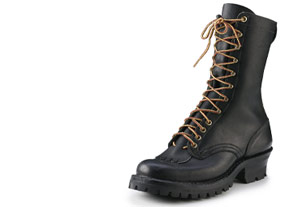
Including of Danner boots, White’s is considered the best fire boot manufacturers in the world. Moreover, White’s places a premium value on durability and the ability of the user to extend the lifespan of the boot by making it completely rebuildable.
Unfortunately, the comfort of White’s boots is a bit of a mixed bag. For instance, these boots are tied for the lightest pair on our list at 2 pounds. However, these boots also have a relatively lengthy break-in period which can lead to sore feet for weeks until they mold properly.
- Tied for the lightest pair of boots on our list at 2 pounds
- Incredibly durable leather and construction
- Completely rebuildable, extending the total lifespan of the boots
3. Scarpa Fuego Mountaineering Boot – Most Stable
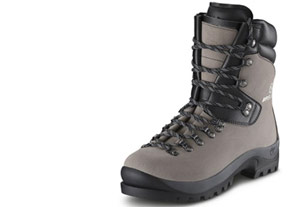
Scarpa may not have the same name recognition in the fire boot market, but the company is already well-known in the hiking boot market. As such, it is a relatively easy transition for Scarpa to apply their manufacturing techniques to the boots that are rated for NFPA standards.
This leads to a boot that can boast some of the best ratings in many of the top priority qualities consumers look for in fire boots. For instance, the single-piece construction and properly molded design allows the Scarpa’s to offer one of the most secure fits that also provides exceptional stability.
- One of the more stable boots on our list
- The single-piece construction in incredibly durable
- Provides one of the best fits out of any product on our list
4. Thorogood Firestalker Elite Wildland Hiking Boot – Best Quality
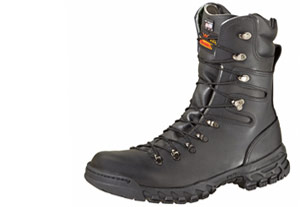
While not always mentioned in the same category as Danner or White’s, Thorogood is another fire boot manufacturer that has a longstanding reputation for producing some the highest quality fire boots available. However, these boots follow the Danner model if anything.
The Thorogoods are designed with a single-piece construction that is also relatively flexible. Unfortunately, these boots are not goodyear welted, and the cement has been known to come undone after extensive use over a relatively short period of time.
- A relatively inexpensive fire boot
- Once broken-in, these are exceptionally comfortable boots
- The triple ribbed logger shank provides excellent stability
5. Bates Ultra-Lites Tactical Sport Boot – Best Price
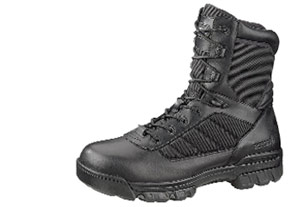
To be perfectly frank, Bates boots are not intended to be used for firefighting. This statement probably goes doubly so for wildland firefighting. The reason for this is that they are not at all NFPA certified.
This means that the Bates boots should likely be seen as a secondary pair of fire boots and not the model used during the heat of the moment. Thankfully, the fairly low cost of these boots compared to other brands on our list makes them ideal for that purpose.
- Less expensive than many of the other products on our list
- One of the more breathable pairs of boots on our list
- Fairly comfortable with short break-in period
6. Bates Ultra-Lites GTX Waterproof Boot – Most Breathable
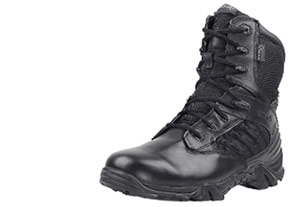
This model of Bates boots is similar to the previous product in almost every way — in terms of features and qualities. Much like the previous Bates boots, this product is not rated for NFPA heat resistance standards and should be seen as a secondary pair of boots.
Thankfully, much like the other pair of Bates, these boots are also somewhat inexpensive — especially compared to the other brands on this list. Moreover, this pair of Bates is waterproof giving it a slight edge over the Tacticals.
- A fairly inexpensive options comparatively
- One of the more breathable pairs of boots on our list
- Fairly comfortable with short break-in period
7. Hathorn 110V Smoke Jumper Fighting Boot – The Lightest
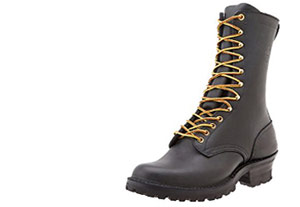
Despite the name, Hathorn is actually a different model under the White’s brand. As such, consumers should expect the same type of quality that comes with White’s boots. Unfortunately, this means consumers should also be aware of the same type of pitfalls as well.
In fairness, the Hathorn brand is basically the more affordable model of White’s boots. However, this does not mean that they are “budget” nor does the quality suffer to the point that they are a poor value. For instance, the same construction, weight, and rebuild-ability can be found in both brands.
- Tied for the lightest pair of boots on our list at 2 pounds
- The goodyear welt construction provides plenty of durability
- The entire boot can be rebuilt to extend its lifespan
8. Thorogood Jump Boot Gen-flex – Best Inner Soles
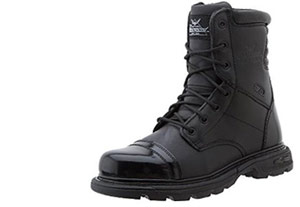
Continuing to provide quality at a lower price, Thorogood makes another appearance on our list. However, this time, the brand’s offering is more in line with the Bates than the other Thorogoods. Specifically, these boots should be seen more as a secondary pair than the primary fire boots.
The reason for this is simple: these boots are not designed to be as fire resistant as primary boots should be. However, unlike the Bates, these Thorogoods do at least offer some legitimate fire resistance. They just should not be used for frontline firefighting.
Unfortunately, you may not be able to make use of that comfort for long as they are also noted to wear out rather quickly — especially if used extensively over a short period of time. Moreover, while they are exceptionally comfortable, they give more during the break-in period and may end up providing up to a size more space than when initially worn.
- A fairly inexpensive option in a generally expensive product category
- Provides some of the best inner soles on our list
- Has a fairly quick break-in period, especially compared to other boots
9. Thorogood Power EMS / Wildland Boots – Most Resistant
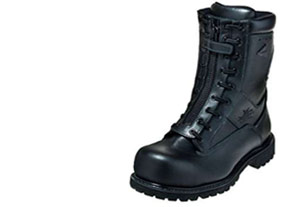
Our final Thorogood is more in line with the first offering of this brand on our list. However, this Thorogood seems to favor the White’s approach to fire boots rather than the Danner approach. Specifically, these are the most resistant boot Thorogood offers on our list.
Not only are the boots water, heat, and puncture resistant, they are also certified to be resistant to blood-based pathogens. This is especially relevant if your wildland firefighting duties require you to administer first aid to casualties of the blaze.
- Generally less expensive than its competitors
- A composite safety toe will prevent heat transferral
- Exceptionally resistant including not just heat, water, and puncture, but pathogens as well
10. La Sportiva Men’s Glacier WLF Hiking Boot – Best All-Round
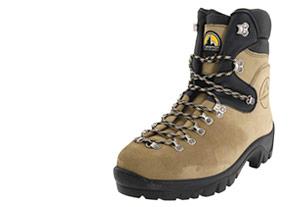
La Sportiva may not be a well-known brand outside of the industry, but firefighters are well-acquainted with them as they are often some of the standard issued models. However, for this offering, La Sportiva provides a boot that is intended to serve double duty as both work boots and play boots.
Essentially, these boots are certified by NFPA heat resistant standard but are also designed to be used as a hiking boot. This means the boots are exceptionally comfortable, though they do have a relatively lengthy break-in period.
- One of the more reasonably priced pair of boots on our list
- Are extremely comfortable once broken in
- Outsole is tested to resist temperatures up to 572 degrees
Wildland Firefighting Boots Buyer’s Guide. Things to consider
Materials
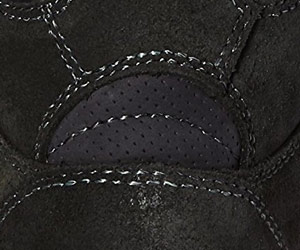
In this regard, most fire shoes are made out of one of two materials: rubber or leather. For a long time, rubber was the preferred material for fire shoes because it is exceedingly difficult to burn. Instead, rubber will often melt well before it burns, and if it is exposed to high enough temperatures for a long enough amount of time, the wearer has other problems to worry about.
However, rubber comes with numerous issues that make it less than ideal as the bulk of a footwear material. For one, rubber is incredibly heavy compared to other footwear material in general and leather in particular. Moreover, rubber is also fairly inflexible which decreases the boot’s overall traction and support. Finally, the excessive weight of rubber makes comfort an issue when fighting a fire that rages for any extended period of time.
Resistance
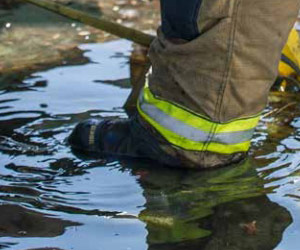
Still, this is not merely limited to resisting fire and extreme heat in general. Considering that firefighters most commonly use water to combat raging infernos — with sand also being used, but only dropped from great height by aircraft — it is important that fire boots also demonstrate a high degree of water resistance, if not water proofing.
Moreover, considering that firefighters will be employing the water at close proximity, the boots will need to be able to handle the rapid shift from hot to cool as the fire heats the boot’s material and the water immediately cools them off. In this way, the boots can crack due to the rapid shifting of temperature if they are not properly treated to resist exposure.
Finally, the toe of the shoe will oddly play an outsized role in its resistance. Specifically, is the shoe made with a steel or composite toe? The better option is the latter with composite being just as strong as steel while also not conducting as much heat. However, composite toe fire boots are also more expensive.
Comfort
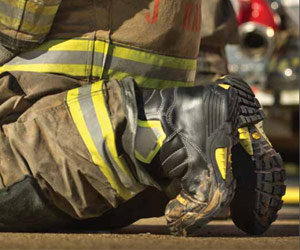
In the previously mentioned study, one of the major sources of injury to firefighters came from tripping. These accidents were directly related to the weight of the boot, with heavier boots involved in a higher incidence of falls. As such, a lighter fire boot, which is inherently more comfortable than a heavier one, is also safer.
Moreover, leather fire boots are not only lighter than rubber ones, making them more comfortable on one end, but more flexible as well. While this additional flexibility offers a few advantages, one of the subtler ones is that it forces the wearer to use less oxygen while walking.
Support
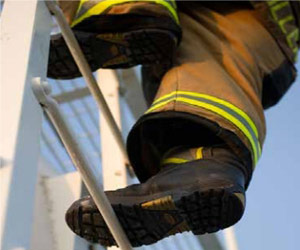
Regardless, the support of a fire boot will often hinge on its construction and be defined by how well it secures the wearer’s foot and stabilizes the ankle. This job is even more important for a wildland firefighter where the often uneven terrain can lead to sprains and falls if the ankle is not properly stabilized.
The other factor in regards to support involves the fire boot’s closure. Most, if not all, fire boots use laces, but the way those laces are secured differs. Generally, eyelets are seen as superior to hooks and loops because there is no risk of the lace coming loose from its point if the hook or loop falls off.
Traction
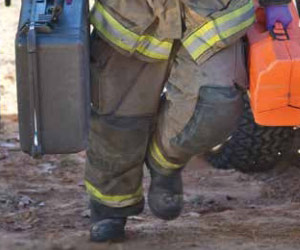
For instance, all types of fire boots need outsoles which are slip resistant. When working with gouts of rushing water, a smooth surface can cause a tumble without slip resistant outsoles. However, in the wildlands, the wearer must not only contend with potentially slippery surfaces, but with incredibly uneven terrain that may be dissolving as well.
The flexibility of the fire boot in general, and outsole in specific, will also play in an important role in the boot’s traction. Unlike the manufactured surfaces station and turn-out boots are liable to walk over, wildland fire boots will need to flex so that they can maintain their traction over uneven and potentially rocky terrain that could also be slick with mud or water.
Conclusion
As we can see, different boots favor different philosophies. While some may provide a better overall value, none of them are without a legitimate place in the market — it simple depends on what the consumer requires.
For the heavy-duty firefighter who stands toe-to-toe with a blazing inferno, Danners, White’s, or La Sportivas are likely your best bet. They are designed with frontline firefighters in mind, though they do differ in terms of durability versus comfort.
If you are a support firefighter or simply used in a “swiss army knife” role, it might not be a bad idea to opt for a lower cost pair of boots that may not provide the same level of heat resistance as the premier brands but are often designed for comfort to the extreme.
Leave a Reply